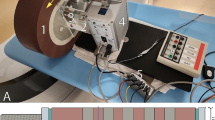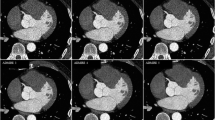Abstract
Objectives
To evaluate radiation dose levels in patients undergoing spiral coronary computed tomography angiography (CTA) on a dual-source system in clinical routine.
Methods
Coronary CTA was performed for 56 patients with electrocardiogram-triggered tube current modulation (TCM) and heart-rate (HR) dependent pitch adaptation. Individual Monte Carlo (MC) simulations were performed for dose assessment. Retrospective simulations with constant tube current (CTC) served as reference. Lung tissue was segmented and used for organ and effective dose (ED) calculation.
Results
Estimates for mean relative ED was 7.1 ± 2.1 mSv/100 mAs for TCM and 12.5 ± 5.3 mSv/100 mAs for CTC (P < 0.001). Relative dose reduction at low HR (≤60 bpm) was highest (49 ± 5%) compared to intermediate (60–70 bpm, 33 ± 12%) and high HR (>70 bpm, 29 ± 12%). However lowest ED is achieved at high HR (5.2 ± 1.5 mSv/100 mAs), compared with intermediate (6.7 ± 1.6 mSv/100 mAs) and low (8.3 ± 2.1 mSv/100 mAs) HR when automated pitch adaptation is applied.
Conclusions
Radiation dose savings up to 52% are achievable by TCM at low and regular HR. However lowest ED is attained at high HR by pitch adaptation despite inferior radiation dose reduction by TCM.
Key Points
• Monte Carlo simulations allow for individual radiation dose calculations.
• ECG-triggered tube current modulation (TCM) can effectively reduce radiation dose.
• Slow and regular heart rates allow for highest dose reductions by TCM.
• Adaptive pitch accounts for lowest radiation dose at high heart rates.
• Women receive higher effective dose than men undergoing spiral coronary CT-angiography.









Similar content being viewed by others
References
Flohr TG, McCollough CH, Bruder H et al (2006) First performance evaluation of a dual-source CT (DSCT) system. Eur Radiol 16:256–268
Kerl JM, Schoepf UJ, Zwerner PL et al (2011) Accuracy of coronary artery stenosis detection with CT versus conventional coronary angiography compared with composite findings from both tests as an enhanced reference standard. Eur Radiol 21:1895–1903
Muenzel D, Noel PB, Dorn F, Dobritz M, Rummeny EJ, Huber A (2011) Step and shoot coronary CT angiography using 256-slice CT: effect of heart rate and heart rate variability on image quality. Eur Radiol. doi:10.1007/s00330-011-2185-4
Moscariello A, Takx RA, Schoepf UJ et al (2011) Coronary CT angiography: image quality, diagnostic accuracy, and potential for radiation dose reduction using a novel iterative image reconstruction technique-comparison with traditional filtered back projection. Eur Radiol 21:2130–2138
Achenbach S (2006) Computed tomography coronary angiography. J Am Coll Cardiol 48:1919–1928
Lehmkuhl L, Gosch D, Nagel HD, Stumpp P, Kahn T, Gutberlet M (2010) Quantification of radiation dose savings in cardiac computed tomography using prospectively triggered mode and ECG pulsing: a phantom study. Eur Radiol 20:2116–2125
Dikkers R, Greuter MJ, Kristanto W et al (2008) Assessment of image quality of 64-row Dual Source versus Single Source CT coronary angiography on heart rate: a phantom study. Eur J Radiol 70:61–68
Tsiflikas I, Brodoefel H, Reimann AJ et al (2010) Coronary CT angiography with dual source computed tomography in 170 patients. Eur J Radiol 74:161–165
Achenbach S, Anders K, Kalender WA (2008) Dual-source cardiac computed tomography: image quality and dose considerations. Eur Radiol 18:1188–1198
Bischoff B, Hein F, Meyer T et al (2009) Impact of a reduced tube voltage on CT angiography and radiation dose: results of the PROTECTION I study. JACC Cardiovasc Imaging 2:940–946
Paul JF, Abada HT (2007) Strategies for reduction of radiation dose in cardiac multislice CT. Eur Radiol 17:2028–2037
McCollough CH, Primak AN, Saba O et al (2007) Dose performance of a 64-channel dual-source CT scanner. Radiology 243:775–784
Jakobs TF, Becker CR, Ohnesorge B et al (2002) Multislice helical CT of the heart with retrospective ECG gating: reduction of radiation exposure by ECG-controlled tube current modulation. Eur Radiol 12:1081–1086
Ketelsen D, Thomas C, Werner M et al (2010) Dual-source computed tomography: estimation of radiation exposure of ECG-gated and ECG-triggered coronary angiography. Eur J Radiol 73:274–279
Stolzmann P, Scheffel H, Schertler T et al (2008) Radiation dose estimates in dual-source computed tomography coronary angiography. Eur Radiol 18:592–599
Kirchhoff S, Herzog P, Johnson T et al (2010) Assessment of radiation exposure on a dual-source computed tomography-scanner performing coronary computed tomography-angiography. Eur J Radiol 74:e181–e185
Gosling O, Loader R, Venables P, Rowles N, Morgan-Hughes G, Roobottom C (2010) Cardiac CT: are we underestimating the dose? A radiation dose study utilizing the 2007 ICRP tissue weighting factors and a cardiac specific scan volume. Clin Radiol 65:1013–1017
Weustink AC, Mollet NR, Pugliese F et al (2008) Optimal electrocardiographic pulsing windows and heart rate: effect on image quality and radiation exposure at dual-source coronary CT angiography. Radiology 248:792–798
Deak P, van Straten M, Shrimpton PC, Zankl M, Kalender WA (2008) Validation of a Monte Carlo tool for patient-specific dose simulations in multi-slice computed tomography. Eur Radiol 18:759–772
Protection ICoR (1990) ICRP Publication 60: 1990 Recommendations of the ICRP. Annals of the ICRP Volume 21/1–3. International Commission on Radiological Protection
Yushkevich PA, Piven J, Hazlett HC et al (2006) User-guided 3D active contour segmentation of anatomical structures: significantly improved efficiency and reliability. NeuroImage 31:1116–1128
Kalender WA, Schmidt B, Zankl M, Schmidt M (1999) A PC program for estimating organ dose and effective dose values in computed tomography. Eur Radiol 9:555–562
Hausleiter J, Meyer T, Hadamitzky M et al (2006) Radiation dose estimates from cardiac multislice computed tomography in daily practice: impact of different scanning protocols on effective dose estimates. Circulation 113:1305–1310
Ketelsen D, Fenchel M, Buchgeister M et al (2011) Estimation of radiation exposure of different dose saving techniques in 128-slice computed tomography coronary angiography. Eur J Radiol. doi:10.1016/j.ejrad.2011.01.052
Rastenyte D, Tuomilehto J, Moltchanov V, Lindstrom J, Pietinen P, Nissinen A (1997) Association between salt intake, heart rate and blood pressure. J Hum Hypertens 11:57–62
Leschka S, Stinn B, Schmid F et al (2009) Dual source CT coronary angiography in severely obese patients: trading off temporal resolution and image noise. Invest Radiol 44:720–727
Burgstahler C, Reimann A, Brodoefel H et al (2009) Quantitative parameters to compare image quality of non-invasive coronary angiography with 16-slice, 64-slice and dual-source computed tomography. Eur Radiol 19:584–590
Techasith T, Ghoshhajra BB, Truong QA et al (2011) The effect of heart rhythm on patient radiation dose with dual-source cardiac computed tomography. J Cardiovasc Comput Tomogr 5:255–263
Rixe J, Rolf A, Conradi G et al (2008) Image quality on dual-source computed-tomographic coronary angiography. Eur Radiol 18:1857–1862
Kerl JM, Bauer RW, Maurer TB et al (2011) Dose levels at coronary CT angiography—a comparison of Dual Energy-, Dual Source- and 16-slice CT. Eur Radiol 21:530–537
Duarte R, Bettencourt N, Costa JC, Fernandez G (2010) Coronary computed tomography angiography in a single cardiac cycle with a mean radiation dose of approximately 1 mSv: initial experience. Rev Port Cardiol 29:1667–1676
Lell M, Marwan M, Schepis T et al (2009) Prospectively ECG-triggered high-pitch spiral acquisition for coronary CT angiography using dual source CT: technique and initial experience. Eur Radiol 19:2576–2583
Bischoff B, Hein F, Meyer T et al (2010) Comparison of sequential and helical scanning for radiation dose and image quality: results of the Prospective Multicenter Study on Radiation Dose Estimates of Cardiac CT Angiography (PROTECTION) I Study. AJR Am J Roentgenol 194:1495–1499
Bastarrika G, Broncano J, Arraiza M et al (2011) Systolic prospectively ECG-triggered dual-source CT angiography for evaluation of the coronary arteries in heart transplant recipients. Eur Radiol 21:1887–1894
Sun ML, Lu B, Wu RZ et al (2011) Diagnostic accuracy of dual-source CT coronary angiography with prospective ECG-triggering on different heart rate patients. Eur Radiol 21:1635–1642
Alkadhi H, Stolzmann P, Scheffel H et al (2008) Radiation dose of cardiac dual-source CT: the effect of tailoring the protocol to patient-specific parameters. Eur J Radiol 68:385–391
Mahabadi AA, Achenbach S, Burgstahler C et al (2010) Safety, efficacy, and indications of beta-adrenergic receptor blockade to reduce heart rate prior to coronary CT angiography. Radiology 257:614–623
Horiguchi J, Fujioka C, Kiguchi M et al (2009) Prospective ECG-triggered axial CT at 140-kV tube voltage improves coronary in-stent restenosis visibility at a lower radiation dose compared with conventional retrospective ECG-gated helical CT. Eur Radiol 19:2363–2372
Hausleiter J, Martinoff S, Hadamitzky M et al (2010) Image quality and radiation exposure with a low tube voltage protocol for coronary CT angiography results of the PROTECTION II Trial. JACC Cardiovasc Imaging 3:1113–1123
Matt D, Scheffel H, Leschka S et al (2007) Dual-source CT coronary angiography: image quality, mean heart rate, and heart rate variability. AJR Am J Roentgenol 189:567–573
Dewey M, Vavere AL, Arbab-Zadeh A et al (2010) Patient characteristics as predictors of image quality and diagnostic accuracy of MDCT compared with conventional coronary angiography for detecting coronary artery stenoses: CORE-64 Multicenter International Trial. AJR Am J Roentgenol 194:93–102
Protection ICoR (2007) P103: the 2007 Recommendations of the International Commission on Radiological Protection. Annals of the ICRP. ICRP, pp 37(32–34): p 31–332
Acknowledgments
We are grateful to Werner Bautz, Katharina Anders and Gerd Muschiol for their support in the clinical investigation and Marcel von Straten for his technical support in running the Monte Carlo simulations and providing the dose estimations. This study was supported by the German Government, Bundesministerium für Bildung und Forschung (01EX1012B, “Spitzencluster Medical Valley”).
Author information
Authors and Affiliations
Corresponding author
Rights and permissions
About this article
Cite this article
May, M.S., Deak, P., Kuettner, A. et al. Radiation dose considerations by intra-individual Monte Carlo simulations in dual source spiral coronary computed tomography angiography with electrocardiogram-triggered tube current modulation and adaptive pitch. Eur Radiol 22, 569–578 (2012). https://doi.org/10.1007/s00330-011-2300-6
Received:
Revised:
Accepted:
Published:
Issue Date:
DOI: https://doi.org/10.1007/s00330-011-2300-6




